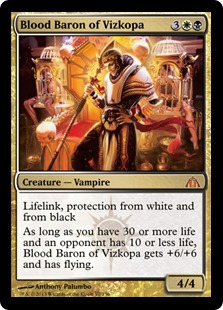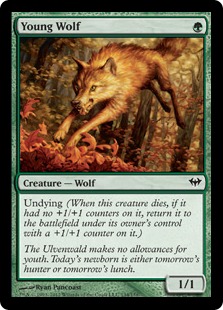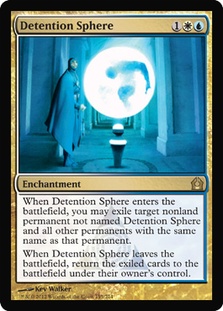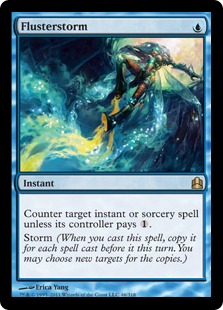On Team Sealed
This past weekend I had a ton of fun in Providence, RI at the Team Sealed Grand Prix. Playing in a team event is unlike any other experience I’ve had in Magic for multiple reasons. For one, you are not completely reliant on yourself, adding an entirely new dynamic to a match. Even if you win, both of your teammates can falter, resulting in a loss. On the plus side, you can lose a match and still win if you’re carried by your teammates. Having people to constantly root for and help out occasionally (and vice versa) is a feeling that is hard to describe.
Before I get into exactly what happened, I would like to thank Tannon Grace and Jonathan Job for being awesome people and doing their best in the event. They were great teammates, and I think we performed much better together than we would have separately. At tough times in each match, we considered the options that player had and made a group decision that we thought was best. There was very little more satisfying than finishing my match quickly so that I could help my teammates make tough decisions. I think we played well, and that’s all we can really ask for.
In single-player events, you have friends you can root for, but it just isn’t the same. Whether or not they win or lose is independent of the outcome of your matches. If you win or lose, it is completely your own fault, and you have only yourself to blame. Your friends will go on to win or lose without you, and the experience can ultimately make you feel stranded. If you are losing, it can be easy to fall into a funk and sink yourself into a hole, and it can be very difficult to shake off. When there are others relying on you to constantly make correct decisions, it can help break that singled-out feeling that so often comes when you lose a match.
I know after most losses in a tournament that I need to take a breather. I walk around outside. I listen to some music. I like to get away from everyone to refocus on the coming matches and finish out the tournament strong. When you’re not doing well in a team event, you have others around you who are feeling exactly the same as you, and you can build each other back up. You have to keep focus and stay strong for the rest of your team or it will ultimately end in disaster.
Before this past weekend, I’d never really had that feeling in Magic, and it stirred something inside of me. I was deeply excited by the prospect of a team event, and I just couldn’t wait to play another match of Magic. It was positively breathtaking, and I’m glad I got to experience it.
In the end, we didn’t quite make the cut for day 2, but I think we tried hard. In fact, I know that I played some of the best Limited Magic I’ve played in quite some time, but a few unlucky draws and a few mistakes in tough combat situations ultimately led to our defeat. It was awkward at times when one of us won and we needed only one more win from the other two, but sometimes that’s just how it goes.
We had an hour to build three decks as well as three corresponding sideboards. We used the entire time, and I think we did a stellar job given our Sealed pool and the time allotted. We went into the event with a few ideas in mind of what we wanted to do, and I think we built our decks to reflect those ideas. For reference:
Deck #1
We knew going into the event that we wanted to build two different decks that were two colors, prioritizing aggressive decks. Red was a very strong color and fairly easy to build around. Going into the event, we figured black or white (Rakdos or Boros) would be the best combination for the most aggressive deck, and we hoped the pool would allow us to do this.
Tannon ended up playing a decent Rakdos deck that was hyperaggressive, featuring a lot of powerful early creatures but lacking much hard removal. This meant he had to kill his opponents quickly before their bomb rares could take over the game. We built his deck to curve out, and we mulliganed aggressively in order to facilitate this game plan.
Deck #2
With the second deck, we built another (mostly) two-color deck that took advantage of a lot of the synergies in the pool. I ended up playing Simic, using two Golgari Guildgates to splash Putrefy and Soul Ransom. While Simic doesn’t have a whole lot of removal, you do have a ton of cards that work very well together. My deck was evolve-heavy and allowed me to progress my board state to overwhelming status as long as my opponent didn’t have a hyperaggressive strategy that put me into the ground before things got up and running.
Beetleform Mage and Simic Charm were absolute all-stars. Civic Saber did a ton of work on the Simic creatures in my deck and allowed cards like Drakewing Krasis and Elusive Krasis to hit much harder than normal. I really miss playing with Bonesplitter, and I felt like Civic Saber was basically a proxy of it in my Simic deck.
Deck #3
After building two different two-color decks, we felt like the third deck should incorporate most of the control aspects of the pool. Job ended up with this deck, and it functioned quite well. With bombs like Niv-Mizzet, Dracogenius and Sphinx’s Revelation, he made good work of the Cluestones and sparse removal at his disposal. We ended up giving Job most of the sideboard cards since his three-color heavy deck could make better use out of most of them.
The one downside to his deck was that we didn’t have enough Guildgates for him to use the Gatekeepers to the best of their ability. I really wanted to have this particular control deck utilize all of the Gatekeepers fully. They were slow enough already that a few Gates wouldn’t really hurt them, but the way we built our decks it just wasn’t feasible.
After we built our decks, the first few matches went rather smoothly. We drew well, and I think we helped each other just enough to give us a significant edge against weaker opponents/decks. When we got into the later rounds, we faced stronger opponents with stronger decks, and a lot of our games ended up coming down to mana screw or mana flood. I’m not complaining, as I know this is just another part of the game. With multiple matches going at once, you hope to dodge these situations mattering as much as they normally do. Unfortunately, we had mana problems in a few games and just blatantly lost other games to end up losing a few matches in a row and knock us out of contention for day 2.
It was a little heartbreaking to make the ten-hour drive to Providence and practice all week, only to have the rug swept out from under us. I know that we could have tested more, and that is definitely my fault. I had a lot of work to do the previous week, and I’m sure that contributed to our overall performance. I can only thank Job and Tannon for making the trek to Roanoke and putting in the time to have a great week. It was a ton of fun, and I am definitely looking forward to it again.
If I had to choose the next team event, I think I would pick a Constructed format. I don’t know which format, but I think bringing back Team Constructed would be awesome. The restriction of only being able to use four of any one card among all three decks makes for some interesting deckbuilding decisions, but finding the "perfect three" decks for a given format would just feel amazing.
In Team Sealed, you are often at the mercy of the pool of cards you open. This, at its core, is one of main reasons why I dislike Sealed as a format. It is rare that you are on the same playing field as your opponent, whereas it is exactly the opposite in Constructed. You all have access to the same card pool, and you can build whatever you want out of that card pool. No one is subject to bomb rares. No one is limited by the removal or color fixing that they are randomly given.
But, as I’ve said before, Draft is a completely different story. Sure, there can be a few of those random elements added in, like the occasional mythic rare that just ends the game, but sculpting out a deck over the course of 45 picks is incredibly skill-intensive. A similar argument could be made for building the best deck out of a Sealed pool, but the two just aren’t even remotely the same. Seeing your picks wheeling around the table before they actually do and being rewarded for it is just surreal.
Improving Decks for Standard and Legacy
But onward! Next weekend, StarCityGames.com is coming to Columbus (and the Origins Game Fair) for an Open Series! I will be in attendance, barring some outrageous weather or circumstance, and am looking to battle with some sweet decks. After a few more weeks of results, I have some ideas in mind for Standard, though I’m not sure which is best.
For one, I’m sick of Junk Reanimator. I’ve played it a ton over the last few months, and I don’t think it’s where I want to be. The same can be said for most aggressive decks, and Sphinx’s Revelation decks, and… Well, maybe I don’t have any good ideas left. Standard is a tumultuous beast. The best way to approach it is to try to improve an archetype you are comfortable with. Of course, I tend to change decks from week to week, so maybe I should just follow my own advice and evolve Junk Reanimator!
But you know that ship has probably sailed when Brian Braun-Duin is moving on. He ended up playing Brad Nelson Junk Aristocrats deck a few weeks ago at #SCGBALT, falling just short of the Top 8 while our very own Bard Narson took it down. The deck looks sweet, and I’m definitely going to be talking to Brad over the next few days to see if he still thinks the deck is good and how it can improve.
If you watched his videos earlier this week and some of our videos last week, you’ll know that Brad is pretty high on Blood Baron of Vizkopa. The card is incredible for the Junk Aristocrats mirror, as it attacks through virtually all of the creatures and is almost impossible to kill. It dodges Tragic Slip as well as any other sort of removal spell you can throw at it. The lifelink makes it akin Baneslayer Angel in racing situations, and it is nothing short of amazing against most aggressive decks. Without a big answer like Ghor-Clan Rampager or Mizzium Mortars, it is incredibly hard to defeat.
Brad also thinks that Young Wolf could easily be better than Doomed Traveler and potentially deserves more slots. While you would have to trim a bit off the top end, the card has some incredibly synergy with the rest of the deck, giving you all sorts of play with Cartel Aristocrat and Varolz, the Scar-Striped.
Young Wolf is pretty low on the power scale, but this deck cares way more about the interaction between its cards than individual success. While Blood Baron is great on its own, Young Wolf thrives when your deck is operating on all cylinders. There is the argument that having too many cards that are reliant on positive interactions is risky, but this deck doesn’t function the same way that most other Standard decks do.
This weekend I will probably be sleeving up something similar to this for the Standard Open:
Creatures (24)
- 3 Skirsdag High Priest
- 4 Doomed Traveler
- 2 Young Wolf
- 4 Blood Artist
- 4 Cartel Aristocrat
- 3 Varolz, the Scar-Striped
- 4 Voice of Resurgence
Planeswalkers (3)
Lands (25)
Spells (8)

While nothing is set in stone, you should probably watch Brad’s videos from earlier this week to get a better feel of the deck and how it operates in each matchup. I haven’t played it nearly as much as Brad or BBD, but I know the deck is quite good. At the very least, you should prepare yourself to beat it.
The deck I’m going to play in the Legacy portion of the event is probably locked in. I absolutely loved playing Esper Deathblade at the Legacy Open in Baltimore, but it really needs some work. Show and Tell is a tough matchup in most forms; Deathblade needs a good way to play around Leyline of Sanctity. Of course, Leyline of Sanctity isn’t the actual problem. The combos in Show and Tell decks are quite powerful, so having more ways to interact with them that get around Leyline of Sanctity is probably the answer.
The short list of cards that could be played in Deathblade to help out against Show and Tell is as follows:
Detention Sphere is a card that should have been in the deck to begin with in some form or another. D-Sphere gives you a catchall answer to a lot of problematic permanents and is great for the wide-open field that Legacy usually brings. With so many random artifacts, enchantments, and planeswalkers running around, it can’t hurt to have a pseudo Vindicate that is also blue for Force of Will!
The main reason to have Detention Sphere over anything else is Show and Tell itself. Most players will be putting some form of enchantment or large monster into play. When Show and Tell resolves, you will get to put your Sphere into play, and the trigger will go on the stack (and subsequently resolve) before the opponent gets to cast their big finisher. When the opponent is reliant on Omniscience, Dream Halls, or even tapping out for Sneak Attack, having this kind of answer is key.
A lot of other blue-based control decks use sweet legends like Venser, Shaper Savant, but I don’t know if we can afford something so costly with so little upside. While Detention Sphere does look awkward against an opposing Abrupt Decay, you definitely want access to a few so that you can protect yourself from Show and Tell.
I highly recommend actual counterspells in the sideboard for this archetype. With so many Leyline of Sanctitys in the sideboards of combo decks, it can be difficult to interact with them with just Thoughtseize and Inquisition of Kozilek. Being too reliant on these effects will ultimately be your downfall should your opponent ever decide to aggressively mulligan for their best card against you.
Once Leyline of Sanctity is in play, your only means of protection is Force of Will. The fact that they have access to Force of Will, Misdirection, and potentially Pact of Negation from the Dream Halls versions means you’ll be in a world of hurt if you can’t interact with them any other way. Having a card like Spell Pierce or Flusterstorm to slow them down will gain you a significant edge when you are able to apply pressure in the meantime. Cards like Dark Confidant and Geist of Saint Traft put a lot of pressure on the opponent to combo off quickly before you overload them with disruption or damage.
The upside of Spell Pierce is that it can counter things like Dream Halls and Sneak Attack. The downside of Spell Pierce is that they can play around it pretty easily by just waiting a turn or two. Ancient Tomb and City of Traitors are incredibly annoying when Spell Pierce is your main avenue of attack, but you have to do something! Actual Counterspell might be better suited for the job, but it can be taxing on your mana on the turns when you need it most. It is basically impossible to cast a card that pressures the opponent while still holding open mana for Counterspell.
The upside of Flusterstorm is that it is much harder for your opponent to resolve Show and Tell. Flusterstorm creating multiple copies means that Force of Will, Misdirection, and Pact of Negation will ultimately be useless. The downside is pretty obvious, as you can’t counter some of the key components in many decks. With U/B Tezzeret winning the last Legacy Open in St. Louis, you’ll likely need your counterspells to be more flexible. At the moment, I think a mix is probably correct.
This inclusion is probably a bit more ambitious, but I think Daze would fit well in this style of deck. You are already utilizing Wasteland along with Deathrite Shaman to cause a lot of problems for the opponent, and having a soft counter in the early turns to protect your better creatures (like Dark Confidant) could be huge. While it won’t always do what you need it to do, Daze is often more valuable than Force of Will in the early turns since you don’t need an extra blue card to discard to it.
While playing Daze would require more disruption, like the fourth Wasteland, I think could be awesome. I’ve played Daze alongside Stifle, Wasteland, and Stoneforge Mystic to great success in the past (though I also had access to Mental Misstep, so there’s that), and I think something similar could be replicated. I might be going a bit off the deep end, but I am always a fan of cheap creatures and cheaper disruption in Legacy.
Changing the mana base is also probably going to happen. While the basic lands were decent against Wasteland and Blood Moon, I had a few too many problems casting my spells when I naturally drew the basics. If I were playing two colors, it would be easier to justify basic lands as a way to easily keep myself out of Wasteland range. However, I think this deck should focus on an avenue of attack that doesn’t care much about the opponent’s Wastelands. Deathrite Shaman and Wastelands of your own should get more attention.
If I change the mana base a bit, it would give me the ability to play Abrupt Decay. This would be a phenomenal addition to the deck, giving you more answers to annoyances like Chalice of the Void while also acting as an uncounterable answer to opposing Tarmogoyfs and Delver of Secrets. Delver decks are favored against you if they have an opener that consists of an early Delver of Secrets followed by a few disruptive spells. Having Abrupt Decay could singlehandedly solve this problem!
Aside from that, the rest of the deck felt awesome. For what it’s worth, I felt highly advantaged against any deck that was playing "fair," and I definitely had game against the combo decks as well. With such powerful disruption in Force of Will and Thoughtseize, it was tough for a lot of them to function. The drawback of playing cards like Thoughtseize is that most combo decks in Legacy have a ton of ways to dig for alternate copies. Taking away their Show and Tell will only buy you so much time since Ponder and Brainstorm will find the combo again in a hurry. The easiest way to lose is to rely too much on the disruption without having a way to actually pressure them while you’re taking away valuable combo pieces.
If I end up playing Esper Deathblade again this weekend, here is the list I will most likely play:
Creatures (14)
Planeswalkers (3)
Lands (24)
Spells (19)

While I only have two "hard" lands to cast Abrupt Decay, Deathrite Shaman can fill a few of those gaps. You are only playing two of them, but the added removal and versatility that Abrupt Decay brings is sweet. You are a little more vulnerable to Blood Moon, but I don’t think a few basic lands will help you win that war anyway. Wasteland could be bad alongside some pressure out of a Delver deck, but you have a lot of lands and a lot of ways to come back from it. Abrupt Decay also helps to stifle the bleeding from their threats without them being able to counter it.
I also like that Abrupt Decay gives you more game against Counterbalance, which is pretty huge. I found myself folding to that card a reasonable amount, and that isn’t something I enjoyed. Abrupt Decay won’t always dig you back out of those jams, but it could certainly help!
With the addition of more green cards to the deck, the sideboard could see a little change. I don’t want to alter it much, as I got to use most of the cards in it a lot. Meddling Mage seems awesome as a proactive answer to Show and Tell and other combo decks, but I didn’t get to use it enough to figure out whether it is actually good. Surgical Extraction is in the same boat, but I think both cards are good enough to warrant more play.
With the trimming down of discard effects, I cut a Snapcaster Mage. It was usually underwhelming, though it does help a lot in matchups where you need more removal spells. The addition of Abrupt Decay should alleviate a few of those problems, but the extra body of Snapcaster Mage is also sweet alongside Umezawa’s Jitte. With that in mind, I might want to play a few copies of Lingering Souls in the 75 to give myself more bodies to actually pressure my opponent’s planeswalkers since it is such a great card for the mirror.
Well, that’s all for this week! Keep an eye out for me in the coverage this weekend at SCG Open Series: Columbus! I’m excited to battle Constructed again, but the Team Sealed Grand Prix in Providence was a lot of fun. I can’t recommend team events enough, as they will help you grow as a player and as a friend. When you win your match and your buddies lose both of theirs, it can be a good character builder to see how you interact with them! The same can be said when you lose your match and both of your buddies win theirs. The swings can be pretty brutal, but the team dynamic is just awesome. I can’t wait for the next one!
Thanks for reading.
strong sad on Magic Online
@strong_sad on Twitter







